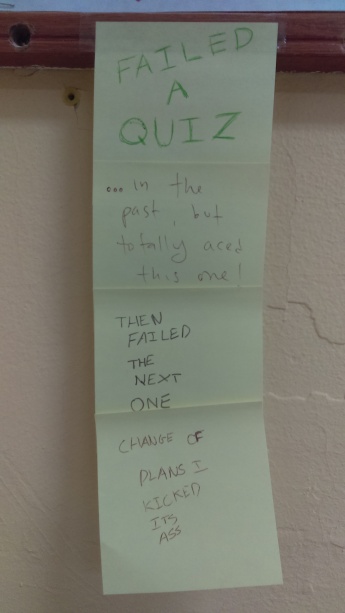
Look at me! On time this week! Barely, but still. #nailedit
Alright, this week’s challenge is to blog about one of my favorite things. Of course the “no d’uh” answer is the kids. However, last week I didn’t really talk about teaching or math at all, so in an effort to direct this back towards the overall teachy-mathy theme at hand, I thought this would be a good time to share my grading policy for tests and quizzes.
I’ve actually been reflecting a lot on that this week, because the kids just took their midterms. We run on a different schedule and exams happen the last week of the 2nd quarter (the last week of the 4th quarter for final exams), so I don’t get to grade these the same way I would their normal assessments during the rest of the year. Which is, I must say, kind of a bummer, because I’ve really come to embrace the way I usually grade them.
A lot of teachers do “test corrections.” Kids get the opportunity after their exams to make corrections and improve their scores. I do something similar, but with a little twist. It’s an idea I picked up from my first student teaching mentor. He called it “rough grading,” so that’s what I call it too.
Kids take their tests. At the end of the period, I collect them. That afternoon/evening, I go through all of them and mark their correct work with a little “+” symbol. If there’s anything incorrect about their work, it just gets left blank. The next day, they get the beginning of class to look over their rough graded tests/quizzes and make adjustments, fix things, etc. It gives them the advantage of not losing points for silly mistakes (assuming they can find them), of course. But they also have the opportunity to at least see the quiz, then go home and study up that night so they don’t completely bomb the whole thing if they’re not adequately prepared.
One of the things I really like about it is that if a kid is just in a bad mental space on that particular day (reminder: I work with kids who have behavioral and emotional difficulties), his/her grade can really improve, simply because of being in a better place the next day. Another thing is that there’s still a lot of personal responsibility the kids have to take. They don’t get to do corrections open-book or with a partner; they still have to finish their assessments in testing conditions, on their own, and it happens immediately following the original attempt. Lastly, some of the best learning I’ve seen from kids takes place when they’re looking for errors in work, rather than trying to solve something from scratch. They often flounder when I try to give them “find the mistake” problems, but when they’re looking for a mistake in their own work, they’ve seemed much more invested and really proud of themselves when they finally do find it.
Which brings me back to midterms this week. I really wish the kids had the opportunity to have them rough graded. I mean, I could, but it wouldn’t go towards their Q2 grade. And, realistically, they’re not going to have this luxury in college. But when you see a kid quit halfway through who you know could finish most of the exam, it’s pretty disappointing. On the bright side, it makes me realize how much I love the rough grading system, and I honestly don’t think I would’ve had the idea on my own. So all my students have Mr. Denny to thank for that.
Here’s the effect of the rough grade in action. Kid arrived for the quiz and before even beginning he wrote this sticky note and stuck it on his own forehead. I took it from him and the next day, after he got to finish (and did so strongly), I added another sticky note to it. We put it on the wall to remind him why he shouldn’t quit before he’s given things his best effort. He added the next two sticky notes himself after subsequent quiz.

Love this!!! My policy has always been retakes, but then they have to start over from scratch. I am going to immediately switch to rough grading! Thanks!
LikeLike
When I was in the public school trying this, there were definitely some kids taking “advantage” of the policy. I put that in quotes because, as long as they’re operating within the parameters I’ve laid out for them, then they’re still playing by the rules and it’s fair game. But it’s something to watch out for. If it seems like the majority of the class is using it as a crutch, you can always adjust (or threaten to take it away). It honestly hasn’t been a problem at my current school, though! And because the kids I work with are so so so anxious, I think it helps them to know that it’s not a “one chance and you’re done” scenario, which tends to make them panic and shut down.
LikeLike
Ha! Love his “change of plans!” I may have to try this out with my next quiz!
LikeLike
That kid cracks me up. Most of the photos I take around the classroom are things he’s written or drawn. He’s a senior, so I really don’t know what I’m gonna do without him next year.
LikeLike
I like this much better than retakes. Making sense of mistakes is so important to understanding mathematics. It’s great that you give your students this kind of learning opportunity.
LikeLike
It also makes my job easier! I get to scan through them quickly, then fully grade them once. Better than doing two full grades.
LikeLike
I did rough grading for one quiz this year, but didn’t feel encouraged to keep going with it. I think I’ll give it another shot, now.
LikeLike
It might not work well with every group. I can see that. What, specifically, do you think made you feel discouraged (or at least not encouraged) to keep it up?
LikeLike
Z
Thank you for sharing. I have a Geom Quiz and think I will give this a go! And I love the chain of post- it’s!
LikeLike